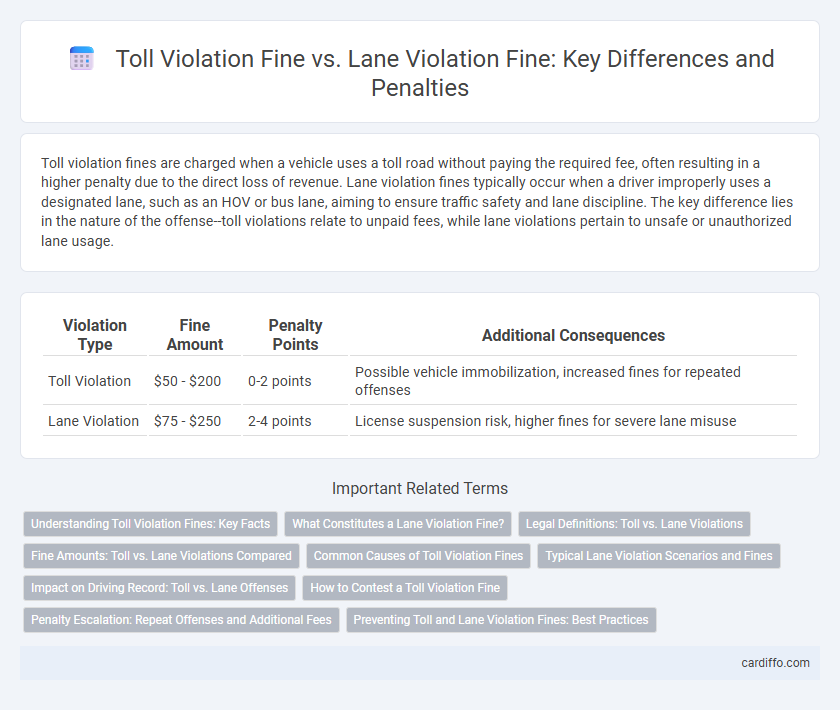Toll violation fines are charged when a vehicle uses a toll road without paying the required fee, often resulting in a higher penalty due to the direct loss of revenue. Lane violation fines typically occur when a driver improperly uses a designated lane, such as an HOV or bus lane, aiming to ensure traffic safety and lane discipline. The key difference lies in the nature of the offense--toll violations relate to unpaid fees, while lane violations pertain to unsafe or unauthorized lane usage.
Table of Comparison
| Violation Type | Fine Amount | Penalty Points | Additional Consequences |
|---|---|---|---|
| Toll Violation | $50 - $200 | 0-2 points | Possible vehicle immobilization, increased fines for repeated offenses |
| Lane Violation | $75 - $250 | 2-4 points | License suspension risk, higher fines for severe lane misuse |
Understanding Toll Violation Fines: Key Facts
Toll violation fines are penalties imposed when drivers fail to pay the required toll fees while using toll roads or bridges, often resulting in higher charges than the original toll. These fines are typically tracked through electronic toll collection systems such as E-ZPass, and unpaid fines can lead to increased penalties, vehicle registration holds, or even legal actions. Understanding the distinction between toll violation fines and lane violation fines--where the latter involves improper use of designated lanes like HOV or bus lanes--helps drivers avoid confusion and ensures compliance with transport regulations.
What Constitutes a Lane Violation Fine?
A lane violation fine is imposed when a vehicle strays from its designated traffic lane, often detected by road sensors or cameras monitoring specific lane usage, such as HOV or toll lanes. This fine differs from a toll violation fine, which occurs when a driver fails to pay the required toll fee, regardless of lane positioning. Lane violation fines aim to ensure safe and orderly traffic flow by penalizing improper lane changes or use.
Legal Definitions: Toll vs. Lane Violations
Toll violation fines arise when a driver fails to pay the required fee for using toll roads, bridges, or tunnels, which is defined under transportation and motor vehicle laws. Lane violation fines are imposed for improper lane usage, such as driving in restricted lanes or unauthorized access to high-occupancy vehicle (HOV) lanes, governed by traffic regulations and road safety statutes. Legal definitions differentiate toll violations as payment infractions, while lane violations pertain to improper road behavior and lane discipline.
Fine Amounts: Toll vs. Lane Violations Compared
Toll violation fines typically range from $50 to $100, depending on the state and frequency of the offense, while lane violation fines often start at $100 and can exceed $200 due to increased safety risks. Toll violations usually incur a lower penalty because they primarily involve unpaid fees, whereas lane violations attract higher fines reflecting their potential to cause accidents. Enforcement agencies emphasize stricter fines for lane violations to discourage dangerous driving behavior and maintain road safety.
Common Causes of Toll Violation Fines
Toll violation fines commonly arise from unpaid tolls due to insufficient funds on electronic toll accounts, failure to activate toll tags, or incorrect license plate information. Another frequent cause is bypassing toll booths via unauthorized lanes or using discounted lanes without proper authorization. These violations prompt fines aimed at recovering lost toll revenue and maintaining traffic flow compliance.
Typical Lane Violation Scenarios and Fines
Typical lane violation scenarios include crossing solid lane markings, improper lane changes, and driving outside designated lanes on toll roads, often resulting in fines that differ from standard toll violation penalties. Lane violation fines typically range from $50 to $200, depending on the severity and jurisdiction, whereas toll violation fines may be higher due to unpaid toll charges and administrative fees. Enforcement relies on automated camera systems and electronic monitoring to identify infractions and ensure compliance with traffic regulations.
Impact on Driving Record: Toll vs. Lane Offenses
Toll violation fines typically do not affect a driver's license points or insurance rates, as they are treated as civil infractions focused on payment compliance. Lane violation fines, related to improper lane usage or unsafe lane changes, often result in points added to a driving record, increasing insurance premiums and potentially leading to license suspension. The sharper impact on driving records comes from lane violations, which carry consequences for driving behavior and legal standing beyond monetary fines.
How to Contest a Toll Violation Fine
To contest a toll violation fine, gather evidence such as payment receipts or valid toll transponder records to support your claim. Submit a formal dispute through the toll authority's website or mail, clearly explaining the situation and attaching all relevant documentation. Acting promptly within the specified contestation period increases the chances of a successful resolution or fine reduction.
Penalty Escalation: Repeat Offenses and Additional Fees
Toll violation fines increase significantly with repeat offenses, often doubling or tripling after the first unpaid toll, reflecting escalating penalty structures designed to enforce compliance. Lane violation fines, such as those for unauthorized use of high-occupancy or restricted lanes, also accumulate additional fees and surcharges upon repeated infractions, including higher administrative costs and possible vehicle hold measures. Both violation types impose additional penalties over time, emphasizing the importance of timely payment to avoid costly legal and financial consequences.
Preventing Toll and Lane Violation Fines: Best Practices
Preventing toll violation fines requires consistent compliance with toll payment systems, such as using electronic toll transponders or prepaid accounts to avoid missed payments. Lane violation fines can be minimized by adhering strictly to designated lanes, observing traffic signals, and utilizing clear lane markings for guidance. Regularly reviewing toll and traffic regulations, combined with maintaining situational awareness, helps drivers avoid fines and maintain lawful travel.
Toll Violation Fine vs Lane Violation Fine Infographic

 cardiffo.com
cardiffo.com